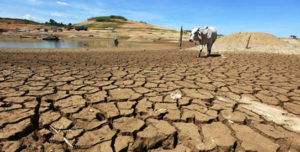Climate change a driver of migration trends in Africa
Africa faces a surge in internal and cross-border migration over the next decade because of the increased effects of climate change and its impact on life and the capacity of people to sustain their livelihoods.
A report from the United Nations Environment Program (UNEP) says environmental factors are having an increasing impact on the movement of people from rural to urban areas.
UNEP Regional Director for Africa Juliette Biao Koudenoukpo says there are increasing migration flows from rural areas to cities by people seeking to avoid harsh or deteriorating conditions.
 “Such migration can have positive and negative impact on the past local coping capacity and environment and also in areas where migrants originate or in areas for temporary or permanent destination,” Ms Koudenoukpo said.
“Such migration can have positive and negative impact on the past local coping capacity and environment and also in areas where migrants originate or in areas for temporary or permanent destination,” Ms Koudenoukpo said.
The scale of such migration both internally and cross border is expected to rise as a result of accelerated climate change and unprecedented impact on lives and livelihood, the recent COP 22 climate conference in Marrakech heard.
“The scale of such migration both internally and cross border is expected to rise as a result of accelerated climate change and unprecedented impact on lives and livelihood,” Ms Koudenoukpo said.
Also, thousands of Africans continue to embark on dangerous journeys to Europe. According to the International Organisation for Migration (IOM), 159,496 migrants had reached Italy by sea this year alone with some 4,220 of them dying in their attempt to reach Europe.
The immigrants cross the Mediterranean via Libya to Italy, which is on the frontline of Europe’s migrant crisis, taking in more than 400,000 refugees over the past three years.
But new research has confirmed that the majority of African migrants continue to move within the continent.
A Comparative Migration Studies report, published in January 2016, analysed the evolution of African migrations between 1960 and 2010. It particularly explores the role of development processes, state formation and policies in explaining trends and patterns of migration.
The report, titled African migration: trends, patterns, drivers explored the role of development processes, state formation and policies in explaining trends and patterns of migration.
Authors Marie-Laurence Flahaux and Hein De Haas say their analysis confirms that the majority of African migrants continue to move within the continent.
“Second, common perceptions of Africa as a ‘continent on the move’ are contradicted by the available data, which strongly suggests that the overall intensity of intra-African migration has decreased in recent decades, with the exception of West Africa,” the authors said.
“This decrease or – in the case of West Africa – stagnation of migration intensities may be related to state formation and the related imposition of barriers towards free movement in the wake of decolonisation as well as the concomitant rise of nationalism and related inter-state and intra-state tensions and violence,” they said.
“In this process, new independent states have tried to assert their newly acquired sovereignty by demarcating borders.
“Apart from the likely role of inter-state tensions in reducing unrestricted migration (such as in southern Africa in the apartheid era and considerably hostility between North African states), this also frequently coincided with considerable xenophobia and anti-immigrant sentiment in African societies.”
The researchers say that while the intensity of intra-African migration has decreased, there has been a recent acceleration and geographical diversification of extra-continental migration from Africa to Europe, but increasingly also to North America, the Gulf and Asia.
“While most extra-continental migration once originated from North Africa, in recent decades there has been a rapid increase in migration from West Africa and, to a lesser extent, East Africa to wealthy countries outside Africa,” they said.
The report also contradicts conventional theories of African migration as essentially driven by poverty.
“In general, African countries with comparatively higher levels of development (such as in the Maghreb or coastal West Africa) also tend to have the highest intensity of extra-continental migration, while the poorest countries (such as many landlocked Sub-Saharan countries) have lower levels of overall migration and most migration is dominated by short-distance migration to nearby countries,” the researchers said.
They say that economic development and associated social transformation initially coincide with increasing levels and a larger geographical reach of migration.
“Increasing income, education and access to information and networks generally increases people’s capabilities and aspirations to migrate,” the authors said.
Laurie Nowell
AMES Australia Senior Journalist












